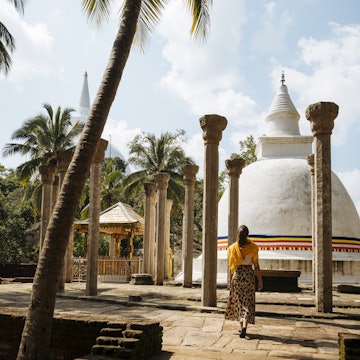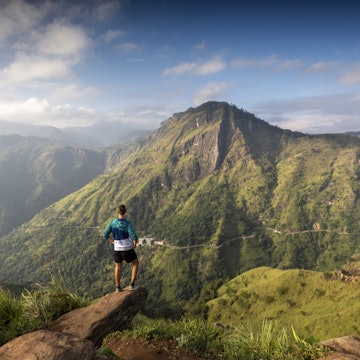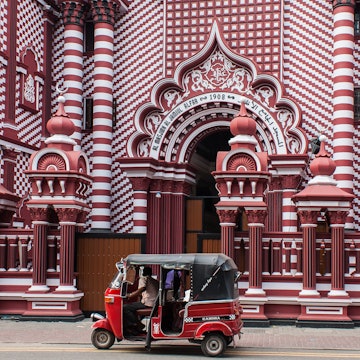

Tangalla, Sri Lanka. Tuul & Bruno Morandi/Getty Images
Sri Lanka is a diverse and wonderful island country containing different ethnicities, religions and cultures. Born here and raised in different regions of this island nation, I’ve now spent enough time abroad to understand how many foreigners perceive my homeland.
So, let’s start with the two most common questions. First, is Sri Lanka safe to visit? Absolutely: this breathtaking island of beaches, rainforests, mountains, spice-laden food and friendly locals makes for an excellent travel destination. The inevitable second question: is it always very hot? There’s no way to sugarcoat it: yes. You’ll either embrace the humidity...or hate it entirely.
And those are just two of many more points to consider as you plan your trip. Here’s all you need to know before you set out for Sri Lanka.
Practical advice for Sri Lanka

1. Two weeks in Sri Lanka is adequate – but a month is ideal
Sri Lanka looks tiny on a world map, it’s true. Yet with so much to do and see, you’ll need at least a month to take in its full scope – like traveling to cave temples in Dambulla, ferrying to far-flung islands near Jaffna, hiking in the Knuckles Range and more. While there’s no shortage of must-visit sites – yes, you really should climb the UNESCO-listed Lion’s Rock in Sigiriya – Sri Lanka is more of a place to slow down, look around and embrace how life is lived here.
Without extended time on your hands, you can get a good taste of in Sri Lanka in two weeks. Spend a week exploring the south-coast beaches with a wildlife safari, and another week split between cultural sites in Kandy and the central highlands.
2. Pick your season wisely
Most visitors assume the only good time to visit Sri Lanka is from December to April. During this high-season window, calmer seas and sunny, blue skies make the south-coast beaches like Unawatuna and Tangalla truly dreamy. High-season weather varies, however, depending on where you are on the island.
When the south coast experiences monsoons from May until October, the east coast (home to some of the best beaches and surf breaks in the country, such as Arugam Bay and Nilaveli) has days filled with sunshine. Even if you come during the rainy season, it doesn’t rain the whole day: instead, expect a daily torrential downpour that lasts for less than an hour. Off-season travel has its perks, too, as prices drop and crowds are far fewer.
And remember to not spend all your time in Sri Lanka at the beach. (a big chunk of your time is fine – the beaches truly are world-class.) Head inland to see the country’s rice fields, enjoy clay-pot cooking in small villages, explore mountain towns with pleasant weather and encounter artists tending to crafts practiced for generations.

3. Get your shots sorted before you set out
Sri Lanka doesn’t require any compulsory vaccines. Nonetheless, consult your healthcare provider at least eight weeks before your visit to see what jabs you should get. Vaccinations for tetanus are usually recommended for all travelers, and some may also need shots for hepatitis A, hepatitis B and typhoid. If you’re staying for more than a month, consider getting a rabies shot (the disease can be fatal if not properly treated, and animals like monkeys, dogs and cats can carry the parasite that causes it).
4. Pack for heat and humidity. Seriously.
Sri Lanka is blazing hot: throughout the year, temperatures in Colombo and south-coast cities like Galle can reach 37°C (98.6°F), with over 90% humidity. The sweltering heat and extreme humidity mean that you’ll need easy, breezy, breathable outfits. For some reason, locals tend to prefer tight denim pieces, but that’s not the most comfortable option if you’re not used to the climate.
Pack pieces made with natural fabrics. Long maxi skirts, linen shorts, dresses, loose-fitting trousers, hats, flip-flops and sandals will all work great. Add some bright colors and pretty floral prints to blend in with the locals. A sweater and a raincoat come in handy if you’re visiting high-country towns like Nuwara Eliya, where temperatures can drop below 10°C (50°F) in the evenings and where conditions can get wet and rainy.
Also remember to keep yourself hydrated and take plenty of electrolytes. Coconut water is available everywhere and is a great way to cool off.

5. Book Hill Country trains ahead in the high season
Those blue trains riding past rolling tea gardens that pop up on your Instagram feed? Yes, they’re a must-do – and the train ride from Kandy to Ella is often considered one of the most beautiful rail journeys in the world. Just remember to book your seats a few weeks in advance if you’re traveling during the peak season (between December and April).
The best place to book these tickets is the official website of Sri Lanka Railways. Trains also have some non-reserved coaches where you can just turn up at the station, buy a ticket and ride, but these compartments tend to get packed with locals going to work and school, and hawkers selling tea and snacks. It’s unlikely you’ll get a seat.
I recommend booking a tourist train such as Ella Odyssey and Dunhinda Odyssey. While tickets are a bit pricier, the trains briefly stop at key sights along the way, allowing you to take in cascading falls, vibrant Hindu temples and charming Hill Country railway stations with manicured flower beds. And you’ll have enough time to snap photos of it all.
6. Hotels aren’t always places to rest your head
Hotel de Plaza. Hotel de Pilawoos. These are but two of the “hotels” you may come across on your travels in Sri Lanka – but they aren’t places to sleep. They are, in fact, where many locals go for a quick bite or an affordable, filling meal.
No one really knows how this tradition of calling such hole-in-the-walls hotels began, but if you want to sit side by side with locals and dig into a plate of greasy kottu (a carb-heavy mishmash of vegetables, meat, egg and cheese) with a sugary, frothy milk tea, these “hotels” are the places to do it.
Etiquette in Sri Lanka

1. You won’t find alcohol served on full-moon days
On full-moon days, called poya days by Sri Lankan Buddhists, devotees visit temples and participate in religious activities. These auspicious, holy days are also dry days, which means that alcohol is not sold in supermarkets, bars or restaurants.
2. Dress appropriately – especially at religious sites
You must cover your shoulders and knees and remove footwear before such religious sites as Buddhist temples, Hindu temples and mosques. In some Hindu temples, men remove their shirts; always pay attention to signs outside. You’ll also avoid unwanted attention if you dress modestly on public transport and in small towns and rural villages, especially if you are a woman traveling alone. Swimwear, including bikinis, is perfectly fine at the beach.
3. You don’t need to speak Sinhala or Tamil – but locals will love it
Sri Lanka has three main official languages: Sinhala, Tamil and English. Many locals speak at least basic English, and you won’t have a hard time getting by as an English-speaking visitor. But throw in a few words like ayubowan (meaning “may you live long” in Sinhala) or vanakkam (meaning “hello” in Tamil), and locals will really appreciate you.
You’ll surely notice locals that don’t greet each other the same way, and are more used to a simple “Good morning” (in English). More-common greetings are Kohomada (“How are you?” in Sinhala) and Enna kathai (“What’s up?” in Tamil).
As a rule, most people in the south of the country speak Sinhala; as you head north and east, Tamil becomes widespread. Tamil is also spoken in the tea estate communities in the central highlands.

4. Learn to eat with your right hand
Sri Lankans eat with their right hand, as the left hand is generally considered unclean (and reserved for toilet matters).
We use our fingertips to mix different curry dishes and condiments with rice. Things like idiyappam (thin, steamed rice noodle mats) aren’t just dipped in curry, but are soaked and mixed with gravy before eating. Locals will appreciate it if you learn to eat with your hands, too.
5. Tipping is not mandatory (but always appreciated)
While no one is expected to tip, drivers and service staff very much appreciate it, especially since Sri Lanka is still recovering from its worst-ever economic crisis. So if you experience good service, consider leaving 10% of the bill as a tip. If a restaurant levies a service charge, Sri Lankans generally don’t tip, as the standard fee will get split among the staff.
Safety in Sri Lanka

1. In Sri Lanka, count on riding in the back seat
While you technically can drive in Sri Lanka, I strongly recommend you don’t. Unfortunately, locals have adopted a driving culture of their own that doesn’t adhere to road safety guidelines; cars and tuk tuks often overtake recklessly and buses are driven with little regard for other road users. Road accidents are common, so it’s better to leave driving to locals and stick to public transport and taxis.
Many foreign travelers ride bikes and even rent tuk tuks (a three-wheeled motorized vehicle) to travel across the country. Many long-distance routes have comfortable and affordable air-conditioned buses. If you are not pressed for time, trains are a great way to get around.
2. Do not drink the tap water
Some locals do drink tap water, which is chlorinated to a relatively safe level, but most Sri Lankans tend to boil and filter tap water before drinking. As a visitor, it is best to avoid tap water altogether, as you may not be used to the microorganisms in it. It’s also wise to avoid brushing your teeth with tap water.
You can find mineral water pretty much everywhere, but be sure to look for the safety-standards seal and check if the bottle’s lid is intact. To reduce your plastic waste, bring a reusable bottle and consider traveling with water purification tablets.
3. Be aware of tuk tuk scams
Use common sense in crowded cities like Colombo and don’t fall for tuk tuk drivers promising to take you to spas, gem boutiques and the best attractions in the city. They’re mostly after a commission from those businesses, and this might get added to your bill. Follow the crowds, and don’t listen to anyone if they tell you a particular entrance to a place is “closed.”
Avoid getting into tuk tuks without a meter. Uber works in main cities, while PickMe – Sri Lanka’s homegrown rideshare app – works in most places. Watch out for tuk tuk drivers gathered at parking lots across Sri Lanka: these drivers are often resistant to rideshare apps, and can even occasionally start brawls with Uber or PickMe riders. Walk a few hundred meters away from them before hailing your PickMe or Uber ride.

4. Maintain your distance from wildlife
On this tropical island, you’ll see wildlife everywhere you go, from peacocks to elephants and monitor lizards that often frequent even urban gardens. Some interior roads in Sri Lanka cross through elephant corridors that wild elephants use for moving across their natural habitats in search of food and water. If you see an elephant on the road, you can observe it from afar – but keep a respectful distance, and never try to offer food.
You’ll also see monkeys all over Sri Lanka. Don’t try to feed them, as they are increasingly becoming dependent on tourists providing food, causing conflict in many areas across the island. In fact, avoid feeding or touching any wildlife at all costs and remember to maintain a safe distance. Consider a stay at a sustainability-focused safari lodge if Sri Lanka’s extraordinary wildlife is a main draw for you.
















